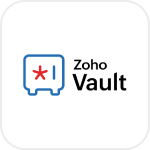
- Overview
- Configuration
Zoho Vault
Safe and secure password sharing with ADManager Plus and Zoho Vault Integration
Zoho Vault is an online password manager for teams and enterprises to manage passwords and other sensitive information safely. The integration between ADManager Plus and Zoho Vault facilitates seamless synchronization between Active Directory (AD) and Zoho Vault, ensuring that user accounts are kept up-to-date across both platforms. This integration leverages your existing Active Directory infrastructure to automate user provisioning within Zoho Vault, eliminating the need for manual account creation and deletion.
Effortless user onboarding
Streamline the process of granting access to Zoho Vault for new hires by automatically creating user accounts and reducing the manual workload for IT teams.
Simplified user offboarding
Automatically revoke access privileges and delete user accounts in Zoho Vault when employees leave the organization, reducing the risk of unauthorized access.
How to integrate ADManager Plus and Zoho Vault
Prerequisites:
Please ensure to provide the client_id and client_secret with permissions to retrieve desired information and perform tasks in Zoho Vault. Refer to Zoho Vault API references for more details.
Privileges:
- To import users (Inbound action): Ensure the account used for authorization has permission to read all user accounts.
Authorization configuration
- Log in to ADManager Plus and navigate to the Automation tab.
- In the left pane, under Configuration, click Application Integrations.
- Under Enterprise Applications, click Zoho Vault.
- Toggle the Enable Zoho Vault Integration button on.
- In the Zoho Vault Configuration page, click Authorization.
- Perform steps to generate client_id and client_secret from Zoho Vault, and paste them in the respective value fields.
- Click Configure.
Inbound webhook configuration
Inbound webhook enables you to fetch user data from Zoho Vault to ADManager Plus. The attribute mapping configured in this section can be selected as the data source during automation configuration to perform the desired action on the list of users received from the API response.
To configure an inbound webhook for Zoho Vault:
- Under Inbound Webhook, click Zoho Vault Endpoint Configuration.
- In the Endpoint Configuration tab, an endpoint, Zoho Vault USERS ENDPOINT, comes pre-configured with an Endpoint URL, API Method, Headers, and Parameters fields to fetch user accounts from Zoho Vault. If you would like to use this pre-configured endpoint, replace team_gid with the team_id of your Zoho Vault instance in the Endpoint URL field. However, if you would like to use a new endpoint to import users, you can configure one using the + Add API endpoint button and filling in the required fields as per Zoho Vault's API references. Click here to learn how.
- The API key value pair is pre-configured as a header for authenticating API requests as configured during Authorization Configuration.
- Macros: You can add macros to your endpoint configuration to dynamically change it as per your requirement using the macro chooser component.
- Refer to Zoho Vault's API references and configure additional headers and parameters, if required.
- Once done, click Test & Save. A response window will display all the requested parameters that can be fetched using the API call. Click Proceed.
- Refer to Zoho Vault's API references to know the Parameters that must be configured to fecth only specific parameters.
- You can configure multiple endpoints for Zoho Vault using the + Add API endpoint button. Click here to learn how.
- Click Data Source - LDAP Attribute Mappingto match endpoints and to map AD LDAP attributes with the respective attributes in Zoho Vault. [ADManager Plus also lets you customize attribute format from Tigerconnect]
- Click + Add New Configuration and perform the following:
- Enter the Configuration Name and Description and select the Automation Category from the drop-down menu.
- In the Select Endpoint field, select the desired endpoint and a Primary Key that is unique to a user (e.g. employeeIdentifier). Note: When multiple endpoints are configured, this attribute must hold the same value in all the endpoints.
- In the Attribute Mapping field, select the attribute from the LDAP Attribute Name drop-down menu and map it with the respective column in Zoho Vault.
- If you would like to create a new custom format for this, click Mapping Attribute.
- Click Save.
Note:
Note:
Outbound webhook configuration
Outbound webhook enables you to update the changes made in AD using ADManager Plus to Tigerconnect or fetch required details from Tigerconnect and synchronize them with AD.
To configure an outbound webhook for Tigerconnect:
- Under Outbound Webhook, click Tigerconnect Webhook Configuration.
- Click + Add Webhook.
- Enter a name and description for this webhook.
- Decide on the action that has to be performed and refer to Tigerconnect's API references for the API details such as URL, and the headers, parameters, and other requirements that will be needed.
- Select the HTTP method that will enable you to perform the desired action on the endpoint from the drop-down menu.
- Enter the endpoint URL.
- Configure the Headers, Parameters, and Message Type in the appropriate format based on the API call that you would like to perform.
- Click Test and Save.
- A pop up window will then display a list of AD users and groups to test the configured API call. Select the desired user or group over which this API request has to be tested and click OK. This will make a real time call to the endpoint URL and the selected objects' will be modified as per the configuration.
- The webhook response and request details will then be displayed. Verify them for the expected API behaviour and click Save.